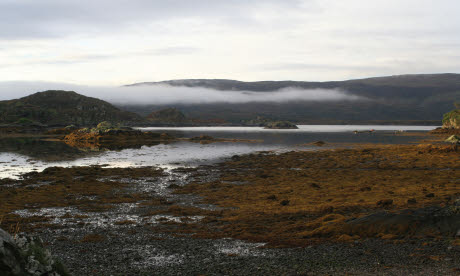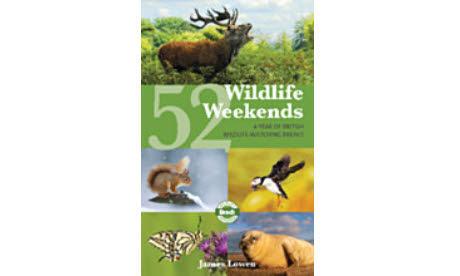
In the following extract from Bradt Travel Guide’s new book 52 Wildlife Weekends, James Lowen shows that the UK has plenty of wildlife-spotting weekends in autumn
In the youthful darkness, you drive remote roads deep in the Scottish Highlands. Slowly, eyes fixed on the carriageway ahead. Your companion swings a spotlight along scree slopes and vegetated hillsides flanking the tarmac.
All is quiet. Then... there! In mid-carriageway, a cat! A stocky feline with flared jowls directs a disdainful look your way, then saunters on striped haunches into the roadside and the night beyond. The thick furred, banded and black-tipped tail provides your parting glimpse of a near-mythical and increasingly rare beast. Wildcat!
An isolated protrusion on Scotland’s west coast that peers southwards towards Mull, Ardnamurchan Peninsula is the best area to see Scottish wildcat. Indeed, Ardnamurchan arguably offers Britain’s finest mammal-watching. Your target list comprises pine marten, otter, harbour porpoise, two seals and three deer. All amidst rugged scenery with craggy hillsides, rocky coastlines, sandy beaches and autumn’s burnt tones.
Such wildlife-watching paradise does not come easy so plan for a long weekend. The drive from Glasgow alone is four hours. Once on Ardnamurchan, some mammals (deer, seals) give themselves up easily but others (otter, pine marten and, of course, wildcat) take time, sharp eyes and luck. But the end more than justifies the effort.
At the eastern base of Ardnamurchan, the A861 sinews beside Loch Sunart. Between Strontian and Salen, pause several times to scan. You should find harbour and grey seals bobbing in the water or lounging on the shoreline. The strand also holds the invasive American mink (unfortunately), water shrew (reportedly, east of Salen) and otter (delightfully). For the latter, two sites stand out: Garbh Eilean Hide at Ard Airigh and the stretch of water leading 500m west from Resipole Farm. Resipole is also the first of several sites for pine marten, which is attracted to food after dark put out by wannabee watchers. (A midnight feast of jam sandwiches, cut into small squares, is optimum!)
In Salen, decant onto B8007 to continue westwards. Checking Loch Sunart should reveal harbour porpoise plus further seals. The road traverses Glenborrodale, another pine marten site; it formerly bred in the hotel roof. Immediately west, halt at RSPB Glenborrodale. Scan for marine mammals from the car park then wander the umber oakclad hillside. There’s a chance of red squirrel, and you should see various fungi.
Heading 3km west, call at Glenmore’s natural history centre, Nàdurra. This is a good place to exchange information on sightings over a cuppa – and to see mammals! Scan slopes northwards for red deer, and southwards for red and roe deer on the islet of Eilean Mòr. Pine marten occurs nearby and brown long-eared bat inhabits the centre itself. Even better, the bay 300m west, Port na Croisg, is a wellknown haunt of otter and both seals. A falling tide is best for twisting and diving otters, especially at either end of the day. What a fabulous place to while away an hour or two!
Continue 2km further west and stop at Cladh Chiarain car park. Look down into Camas nan Geall bay for possible harbour porpoise, eider and red-throated diver. And look up for golden and white-tailed eagles. The latter deserves its reputation as a ‘flying barn door’, while the former is no small fry either.
From Clad Chiarain, the B8007 swings inland. After 5.5km a conifer plantation nuzzles the road, with Loch Mudle lying to your right. Late afternoon, you might bump into pine marten running with rocking-horse gait amidst prostrate pines, a hedgehog or barn owl. You should see the odd roe deer, nervously huddling the wooded fringes, and the recently introduced fallow deer. On the moorland northwest, red deer can be common: as the light dwindles, you should see several herds. For more, continue to the T-junction, then head north on the minor road through Branault and Kilmory to Ockle. Perhaps pop down to the coast just northwest of Kilmory, which can be good for otter.
Once darkness falls (blessedly early in autumn), shift up a gear. Wildcat prospects are highest in the first hours of night, as famished felines hunt voles, but you still need great fortune. Prime terrain is the B8007 from the Kilchoan–Kilmory junction south to Port na Croisg; drive this stretch slowly and repeatedly. The ultimate areas are Doire Darach where the road forges between conifers and Loch Mudle, and the 3km sweep north of Cladh Chiarain (particularly the basin of rush fields northwest of Allt Tòrr na Mòine River and scree slopes 500m further on).
In addition to the car’s beam, train a spotlight perpendicular to the car. Your search image is the ‘twin headlights’ that denote a predator’s forward-facing eyes. To be sure the cat is genetically pure (and only 1% of Scotland’s ‘wildcats’ are thought untainted by tabby), clock the clublike, ringed tail and striped legs, and confirm the absence of telltale hybrid characteristics of white patches or spots. Result!
Where to go: Ardnamurchan Peninsula is west of Fort William. From the A82, use the Corran Ferry to reach the A861. Follow this west through Glen Tarbet then along Loch Sunart. For the hide at Garbh Eilean, 12km west of Strontian, use Ard Airigh car park. Resipole Farm is 3km before Salen, where you switch onto the B8007. Where the road flanks Loch Sunart, good locations comprise: RSPB Glenborrodale; Nàdurra Natural History Centre plus adjacent Port na Croisg and Cala Darach; and Cladh Chiarain car park above Camas nan Geall.
The B8007 between Cladh Chiarain and Loch Mudle is best for wildcat, particularly the scree slopes, the ‘basin’ rush fields north of Allt Tòrr na Mòine River, and Doire Darach. At the T-junction with the Kilchoan–Kilmory road, the right turn ends at Ockle. Find good information on wildcats at www.scottishwildcats.co.uk.
Suggested bases: Villages include Salen, Kilchoan and Glenborrodale (www.ardnamurchan.com); additional accommodation is scattered around the peninsula. With a view over Loch Shiel, Ardshealach Lodge offers four traditionally styled rooms and an on-site restaurant.
Flexibility: Wildcat and pine marten are resident; in autumn, populations of predator and prey should be at their peak, and night draws in early making it easier to see these nocturnal mammals. Weather is important for cats: don’t bother searching during rain, but the first dry night thereafter is optimum. Other mammal targets are resident. In spring/summer you should also see minke whale and perhaps other cetaceans. White-tailed eagle is resident.
Accessibility: 2
 This weekend escape has been taken from Bradt's 52 Wildlife Weekends: a year of British wildlife-watching breaks (£14.99).
This weekend escape has been taken from Bradt's 52 Wildlife Weekends: a year of British wildlife-watching breaks (£14.99).